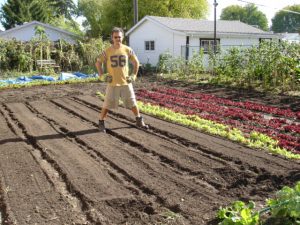Courtesy of Roxanne C., Philadelphia PA
This is the story of Wally Satzewich. He did not come from a farm family. Thirty years ago he began growing in his backyard in Saskatoon, SK, a city of about 220,000. He began selling at the Saskatoon Farmers Market, and that sealed his fate. He realized he was a farmer, and like most farmers back then, he thought that to become successful, he had to get bigger.
So Wally acquired 20 acres outside of Saskatoon, along the Saskatchewan River, and invested in an expensive irrigation system and brought in outside work crews. But he continued to live in Saskatoon and grow in his small yard there.
Over time Wally realized he was growing high value crops, like carrots, spinach and salad mix in his small backyard, and he was growing low value crops, like potatoes and onions, on his larger acreage in the country. This distinction between a high value and low value crop made him realize the other advantages to city-based sub-acre farming.
Wally could grow high value crops in the city because he was not losing them to pests, like deer and large scale insect infestations. His irrigation system in the city was the water faucet, he did not have to depend on fluctuating river levels or worry about water quality. His work crew in the city was he and his wife. He did not have to depend on outside labor.
When Wally looked at the financials is when his head really got turned around because what he saw was that, even though the land base and overhead of a sub-acre farming operation is a fraction of that of a large-scale farm, their bottom lines are similar. So a sub-acre farmer can earn as much, or more, income as a large scale farmer, but with a lot less stress and overhead, and with a lot more control over their operation and with a lot more certainty of success from year to year. So Wally sold off all his acreage in the country, Futility Farm as he called it, and became an urban farmer.
Now, the only land Wally owns in the city is his own small backyard, and he rents or barters other backyards to make up his land base. He has been supporting himself farming this way for over 15 years.
Based on his experience in downsizing Wally realized how effective a systematized approach to farming could be. While he knew that farming was “experiential”, and that farmers had to learn by doing, he also knew that if the only way aspiring farmers could launch their careers was by trailing him around in his backyard plots, it would get pretty crowded up there in Saskatoon. What he needed was to document the system in some way. Together we wrote and produced the SPIN-Farming online learning series.
Launched in March of 2006, it is now being used by thousands of new farmers to get started – and stay – in business. Most, like Wally, do not come from traditional farm families. That may be why they appreciate SPIN’s systematic approach and can make it work. It makes it easier to get started by eliminating the routine trial and error, providing benchmarks to gauge progress, by keeping farmers focused on what matters most to their success. We hope this is where you enter the story…

Wally created the SPIN-Farming system after downsizing. Like, really downsizing. Like, from 20 acres  to less than 1 acre. He’s been farming this way for over 15 years. Â
TO GET AN UP-TO-THE MINUTE UPDATE ON WALLY AND ALL THE OTHER SPIN FARMERS WHO HAVE FOLLOWED IN HIS FOOTSEPS, VISIT WITH HIM HERE.


